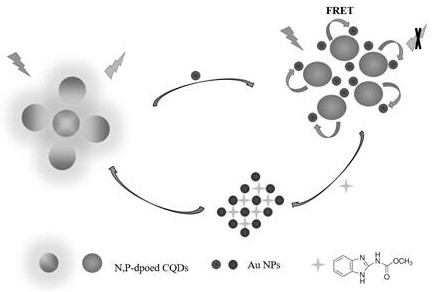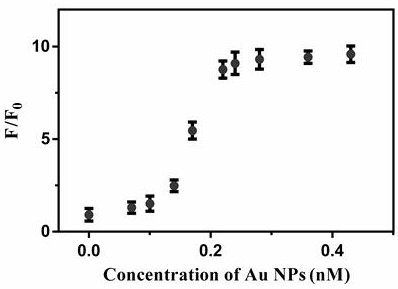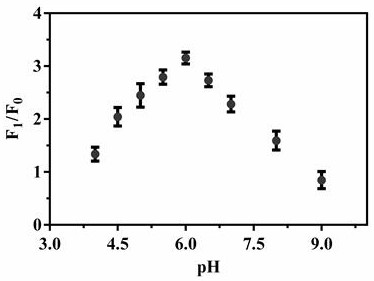A kind of detection method of carbendazim
A detection method and technology for carbendazim, applied in the detection field of carbendazim, can solve the problems of high detection cost, small detection range and long processing time, and achieve the effects of high detection sensitivity, fast detection speed and low detection limit
- Summary
- Abstract
- Description
- Claims
- Application Information
AI Technical Summary
Problems solved by technology
Method used
Image
Examples
Embodiment 1
[0037] 1) Add 0.5g m-phenylenediamine and 2.84g diethylenetriamine pentamethylidene phosphonic acid to 30ml of water to obtain a reaction solution, then ultrasonicate for 5min to make the reaction solution evenly mixed, and then pour the reaction solution into a 50ml reaction kettle After reacting at 200 °C for 5 h, take it out, naturally cool to room temperature, centrifuge at 10,000 rpm for 10 min to obtain the supernatant, then pour the supernatant into a 1000 MWCO dialysis bag and dialyze for 24 h to obtain the carbon dot stock solution. pH=6) diluted 800,000 times to obtain a carbon dot detection solution for detection and set aside.
[0038] 2) Add 2g of chloroauric acid tetrahydrate into 200ml of water, heat it to boiling, then add 6ml of freshly prepared 1% trisodium citrate aqueous solution, stir well, and when the color of the mixed solution changes from black to red, continue to heat for 30 minutes. Take out, cool to room temperature naturally to obtain nano-gold so...
Embodiment 2
[0042] 1) Add 0.5g m-phenylenediamine and 2.84g diethylenetriamine pentamethylidene phosphonic acid to 30ml of water to obtain a reaction solution, then ultrasonicate for 5min to make the reaction solution evenly mixed, then pour the reaction solution into a 50ml reactor at 200°C After 5 hours of reaction, take it out, cool to room temperature naturally, centrifuge at 10,000 rpm for 10 minutes to obtain the supernatant, then pour the supernatant into a 1000 MWCO dialysis bag and dialyze for 24 hours to obtain the carbon dot stock solution. The carbon dot stock solution is buffered with different pH values B-R respectively. The solution was diluted 800,000 times to obtain a carbon dot detection solution for detection, and the pH values were 4, 4.5, 5, 5.5, 6, 6.5, 7, 8 and 9, respectively.
[0043] 2) Add 2g of chloroauric acid tetrahydrate into 200ml of water, heat it to boiling, then add 6ml of freshly prepared 1% trisodium citrate aqueous solution, stir well, and when the...
Embodiment 3
[0047] The test method is the same as in Example 2, wherein the pH value of the B-R buffer solution is 6, and the incubation time is variable, which are 0, 1, 2, 3, 4, 5, 6, 7, 8, 9 and 10 min respectively. Taking the fluorescence recovery intensity as the ordinate and the incubation time as the abscissa, draw a curve graph, and the results are as follows Figure 4 shown.
[0048] from Figure 4 It can be seen that under the same conditions of other factors, with the increase of incubation time, the fluorescence recovery intensity of carbon dots is also continuously enhanced. When the incubation time was 5 min, the carbendazim in the mixed solution fully reacted with the gold nanoparticles, and the fluorescence recovery intensity would not increase if the incubation time was increased.
PUM
 Login to View More
Login to View More Abstract
Description
Claims
Application Information
 Login to View More
Login to View More - R&D
- Intellectual Property
- Life Sciences
- Materials
- Tech Scout
- Unparalleled Data Quality
- Higher Quality Content
- 60% Fewer Hallucinations
Browse by: Latest US Patents, China's latest patents, Technical Efficacy Thesaurus, Application Domain, Technology Topic, Popular Technical Reports.
© 2025 PatSnap. All rights reserved.Legal|Privacy policy|Modern Slavery Act Transparency Statement|Sitemap|About US| Contact US: help@patsnap.com



